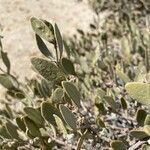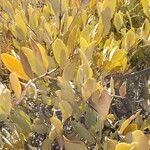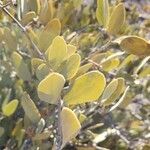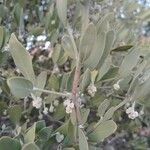An evergreen thorny shrub. It grows 2.4 m high and spreads 1.8 m wide. It often has several stems. The young stems are hairy. The leaves are small and leathery. They are oblong and grey-green. The male and female flowers are on separate plants. The male flowers are cup shaped and yellow. They occur in clusters. The female flowers are bell shaped and greenish. They are in the axils of leaves. The fruit is a capsule with one seed. The seed or nut is about the size of an acorn. The seed is 12-19 mm long. The kernel is triangle shaped.




